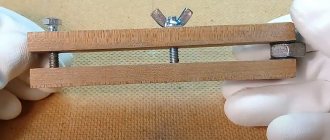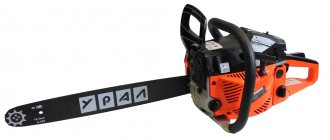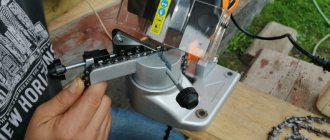Necessary materials
Structurally, all sawmills are divided into two types:
- With the supply of logs to a stationary saw unit.
- With the movement of the saw unit relative to a fixedly fixed log.
The machines of the latter type include the common band sawmills (“ribbons”). Chainsaw-based sawmills are made according to the same principle.
The log is fixed with clamps on the frame, and the saw unit moves along it along the guides.
The main material for such a device is rolled metal. This can be a square or rectangular profile, round pipes, rods, angles, channels and small rails as guides, similar to elevator ones.
This material is used to collect:
- frame on which the chainsaw is mounted,
- frame for placing logs,
- guides for vertical and horizontal movement of the saw unit relative to the log.
It makes no sense to give any cost for such rolled metal. An owner who decides to assemble such a frame on his own can choose either expensive thick-walled hot-rolled steel or lighter-weight cold-bent steel. The only requirement is that the rental must withstand loads and not bend during operation.
In many cases, material for homemade sawmills is simply collected from scrap metal or from available material at hand. Therefore, theoretically, the range of metal prices for a rigid frame is from 0 to 15-25 thousand rubles.
The length of the logs that are supposed to be cut also matters. For a long round timber you will need a bed of the appropriate length. And multi-meter rolled products are much more expensive and are rarely found in scrap metal.
In the video, an example of a compact homemade unit for cutting short lengths.
Wood is not used for the frame because it is susceptible to warping. The location of the log on it will constantly change, and it will not be possible to achieve stable cutting accuracy.
In addition to rolled metal for the frame and guides, you will need screws to secure the saw unit and the log. The assembly of the frame itself is also sometimes performed using threaded connections, especially if the sawmill needs mobility. Then the frame can be disassembled and transported to any place.
For stationary use, welded joints are more often used.
Which saw should you choose?
All hand chainsaws are, in principle, designed for cross cutting. In this case, the operating mode with maximum load can be considered short-term. The thickest log rarely exceeds 0.7-0.9 m in diameter. A cross cut is carried out in a short time. Next, the internal combustion engine cools down for some time, idles or turns off.
When longitudinal sawing, it is necessary to cut up to 6 m. In this case, the chainsaw operates at maximum load for quite a long time. For this reason, only reliable professional chainsaws with a long service life and good maintainability are suitable for such sawmills.
The engine power should be from 5 hp. and higher. As an exception in terms of power, you can use old Soviet-made chainsaws. For example, “Friendship-2” (3 hp), “Friendship 4”, 4 hp. and other models. These are durable units, extremely easy to repair and maintain, and were widely used in industrial logging sites in their time. The same applies to chainsaws of the Soviet Ural brand.
The Ural saw is most often used to make a sawmill with your own hands, especially at home - it is cheap and practical.
The big disadvantage of Soviet chainsaws is their heavy weight. But just when used on sawmills, weight does not matter, the saws are fixed and do not have to be held in your hands.
Among modern chainsaws, we can recommend the professional, original Shtil and Husqvarna.
No one forbids using light household chainsaws with a power of about 2-2.5 hp or a more powerful one from the budget category, for example Kruger GCSK 35-45 or Shtil 180. But the laws of physics and mechanics cannot be fooled. Such power units can only be used for sawing small products, and in practice they will not last long in this mode.
DIY Instructions
Sawmill from chainsaw Ural
Before starting work, a drawing is selected or created, or at least a sketch of the future product. It is advisable that the dimensions of at least the main parts be indicated. This will make the work much easier and faster. It will be possible to immediately cut the workpieces to length, and then begin assembly.
The general appearance and capabilities of the future unit can be selected and seen both in practice, using the example of band saws or chainsaws, and on the Internet in numerous videos on this topic. When choosing options according to the type of which you plan to make your own version, it is better to choose the simplest ones, with a minimum of complications and details.
This video shows the simplest device of this type. We see a pulling cable that the operator winds with the help of a handle, ensuring that the chainsaw is pulled along the log. But at the same time it is clear that the operator not only tightens the cable, but also simply moves the unit by hand. Obviously, a sawmill of this type can be made either with such a broaching device, or in an even simpler version, without it. Then the chainsaw is moved by hand.
The main requirements for any design and material:
- Sufficient strength.
- The absence of large backlashes when the working unit moves along vertical and horizontal guides.
It should be remembered that excessive strength makes the entire structure heavier and more expensive, and too tight a fit of moving parts in the guides eliminates backlash, but can lead to jamming during operation.
Having experience, you can start work without a drawing, or with a simple sketch - a sketch. Work without a drawing is carried out blindly, and unexpected errors often emerge. In addition, all dimensions will have to be remembered or written down on paper. And recording dimensions indicating the location of parts automatically leads to the creation of at least a simple sketch.
After selecting or creating a drawing (sketch), the blanks are assembled. A set of necessary rentals, fasteners and other necessary parts is assembled.
Next, the rolled metal is cut to length, and the blanks are assembled until the entire structure is ready.
We recommend watching the video below for more details on how to make a sawmill from a Ural chainsaw. The author talks in detail about all the manufacturing steps and also gives dimensions. We recommend watching this useful video.
Mini sawmill from Shtil chainsaw
Such units are assembled in exactly the same order and principle as using chainsaws of other brands. But there are a few differences.
The dimensions and shape of the modern Shtil chainsaw are completely different from those of Soviet chainsaws. Therefore, when attaching the chainsaw itself to the frame, fasteners of a different shape and size are used.
When designing, the power of the unit is taken into account. For example, the Shtil MS 880 model with a power of 6.4 kW (8.7 hp) with a bar length of 70 or 90 cm can cut thicker logs of great length. Consequently, in order to use the unit to its fullest, a frame of greater width and length is designed.
How to make a Logosol type sawmill based on the Shtil MS 660 professional chainsaw is shown in the video below. The manufacturing stages are not described, but how it is constructed and the operating principle of the main components is clear.
Portable sawmill from Druzhba chainsaw
When manufacturing a sawmill using this unit, the features of the model are also taken into account. For example, the less powerful “Druzhba 2” is suitable for trimming thin gauges (understock) and does not require a wide and powerful bed. “Druzhba 4” is capable of sawing larger logs, and this is also taken into account during the design.
If the bed is being prepared for any chainsaw, it is advisable to choose a size that is medium in length and width. The mounting location of the power unit must be designed in such a way that a chainsaw of any size and power can be mounted without problems.
We also recommend reading an interesting article about what other useful things can be made from a Druzhba chainsaw.
We recommend watching an interesting video about what type of sawmill can be made using the Druzhba 4 saw. The author talks about how its device works, the principle of operation, as well as the nuances of making it yourself.
Cutting process
After you have learned how to turn on, configure and change some components of the system, you can start cutting.
It is very important to understand how best to position the log and how to fasten it
To do this, consult a specialist and let him give you instructions, where you will see all the nuances step by step. Before starting the saw, be sure to check the tension of the belt, as well as the level of its sharpening.
The quality of the resulting board depends on these parameters. The first few times, make the cut under the supervision of a specialist who will tell you all the nuances, since there are quite a lot of them and it is difficult to remember them the first time.
When cutting, the saw should enter the tree smoothly and without much pressure, as otherwise this may lead to its breakage. Carry out the cut carefully, without sudden movements.
Ripping chains
The tooth shape of any cutting blade for longitudinal and transverse cutting of wood is different. The same applies to chainsaw chains. In a hacksaw or two-handed saw for regular cross-cutting, the tooth is located straight, at 90 degrees (along its axis) to the blade.
In rip saw blades, the tooth is inclined forward. Chainsaw chains for rip sawing have a different sharpening angle. You can find such chains on sale. But they are required quite rarely, so there is not a large selection of them on sale. We have to search. In addition, among the variety of chains for different models and brands, choosing a suitable chain is even more difficult.
When such a chain cannot be found, the old ones are resharpened for cross-cutting. In this case, the sharpening angle changes from the usual 30 degrees to 10, sometimes even 5 degrees (almost perpendicular to the axis of movement of the chain).
Sawing along the grain (lengthwise) of chains with both (30 and 5 degrees) sharpening angles will be at approximately the same speed. But at a sharper crosscut angle of 30 degrees, the chain tends to find places in the wood with the least resistance between the fibers and unpredictably pull the cut in that direction. As a result, the tire may bend, make a crooked cut, or jam.
Opinions about a sawmill based on a chainsaw
Alexey Yuryevich 51 years old, Samara I had a circular sawmill mounted on a table for cutting boards and timber. When I was making a log house for a bathhouse, I decided that I would make the boards myself from round timber. To do this, I welded a sawmill from an old 440 Shtil, which is already God knows how many years old. A friend who works at a metal warehouse helped - the profile, angle and channel came out almost at cost. I only bought a special chain for longitudinal cutting. After I installed the bathhouse, my neighbors began to come to me, either to dismiss one or the other. Everyone will pay a little, but they will say thank you. And I calculated that I invested about 15 - 20 thousand in terms of material, this without a saw. But now I don’t have to order the board - I’ll cut everything myself.
Andrey, 34 years old, Smolensk I made myself a manual machine for dismantling timber from a Patriot 6220 chainsaw. For a person who has a welding inverter, nothing complicated, although I don’t have a welder’s qualification. I sawed about three cubes of timber - the flight was normal. Then I tried to loosen a 40 cm log
Towards the end of the log (6 meters long) the saw began to work poorly. The speed has slowed down
In short, a solid log requires a chain with a lower angle. For the experiment, I took an old one, took it to the workshop, and they sharpened it for me to 10 degrees. The cut became faster, but the load on the saw increased. We have to let her rest.
Ready-made frames and mobile attachments
The modern market offers many options for frames for such sawmills, from the simplest clamps (attachments) costing about only 3,000 rubles. to frames similar to a band sawmill at a price of about 50,000 rubles. The latter are rather flimsy-looking structures with a high probability of vibration during operation. There's nothing complicated about it. It is quite possible to assemble such a structure on your own if you have available materials.
If you use more powerful rolled metal, the structure itself will be much stronger and more reliable than that offered at a fairly high price.
The simplest attachment for longitudinal sawing.
Alternatively, such an attachment can be used as a ready-made unit when assembling a homemade sawmill. It makes it possible to vertically raise and lower the cutting set relative to the log. All that remains is to organize the movement of the nozzle along the horizontal guides of the homemade frame.
Mobile carriage for longitudinal cutting of logs based on the Husqvarna 142 chainsaw
The author of the video tells how he made a mobile carriage for longitudinal cutting of logs based on a Husqvarna 142 gasoline saw. With this saw and carriage he sawed through a very large volume of material and built an entire house. The video contains everything you need to make the device yourself. We recommend viewing, very useful.
Video about the nozzle from the store
You can see what kind of devices they sell in the store in this video.
Classification of chainsaw accessories for sawing logs
Depending on the direction in which the sawing will be carried out, all existing chainsaw attachments are divided into 2 broad groups:
- for longitudinal cutting of wood;
- for cross sections.
Both categories represent a range of industrial adapters that allow you to obtain boards and lumber of the required size, which can then be used for construction or repair.
When there are no factory options available, the only sure way is to make their analogues at home.
How to work with a homemade device correctly
The safety rules when working on such devices are the same as for any woodworking machines. The operator and bystanders must not approach the cutting blade. It is undesirable to work tired, with reduced reaction. Common sense should be used. Clothes should be buttoned and pulled up, without loose hems that could get caught in the chain.
If there is a wide spread of sawdust, you should wear safety glasses. When working for a long time, it is advisable to wear headphones to protect against noise.
Technical features:
- Do not put pressure on the cutting unit. The saw advances as sawdust is removed from the cut, without effort.
- Do not use chains with dull teeth or tires with worn grooves.
Care and maintenance of the entire chainsaw is the same as for normal cross-cutting use. But they are more careful to ensure that the engine does not overheat due to prolonged operation.
Maintaining safety while working
To avoid failures and accidents, you must follow safety precautions when working with materials and tools:
- When working, do not allow strangers to enter the work area, especially children.
- While working,
you should use protection from noise and sawdust that is thrown during cutting. - You should have a first aid kit with everything you need to use in case of cuts.
- When using a circular saw, it must be equipped with a protective cover.
- Do not pour gasoline into a hot chainsaw
. - Use the chainsaw only for its intended purpose and do not run it at full power if it is not working.
- Do not press the saw too hard while working.
- The log for sawing should be installed on the right side.
Chainsaw. This is a handy tool that you can use to make your own boards. It is suitable for use on a private farm where it is necessary to renovate or build new outbuildings. In such cases it is not required. Therefore, they can be easily cut from any logs of the required size. Once you get the hang of it, the work gets done quickly and the quality of the boards is excellent.
Post Views: 8
Chainsaw Partner 340 Malfunctions And Their Elimination
Why does the Huter Electric Saw Chain Often Weaken?
Pros and cons of such devices
The advantage is that with the help of one unit (chainsaw) you can solve many problems - use the chainsaw in the traditional way for cross-cutting and place it on a frame for cutting logs into moldings.
The disadvantages are as follows:
- Poor performance.
- Significant consumption of fuel and oil for cutting 1 cubic meter.
- Thick cut, a large percentage of the wood goes into sawdust.
- Significant, accelerated wear of the chainsaw itself and saw accessories.
As a result, the device can be useful and beneficial when relatively regularly it is necessary to saw small, but not absolutely negligible, volumes of wood. For large volumes, when you need to cut quickly and efficiently, it is better to use traditional sawmills. And vice versa, for sawing only 2-5 logs there is also no point in buying or constructing such a structure.











